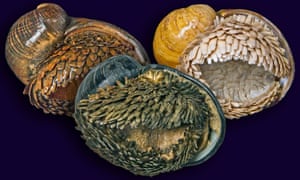The scaly-foot snail is one of Earth’s strangest creatures. It lives more than 2,300 metres below the surface of the sea on a trio of deep-sea hydrothermal vents at the bottom of the Indian Ocean. Here it has evolved a remarkable form of protection against the crushing, grim conditions found at these Stygian depths. It grows a shell made of iron.
Discovered in 1999, the multi-layered iron sulphide armour of Chrysomallon squamiferum – which measures a few centimetres in diameter – has already attracted the interest of the US defence department, whose scientists are now studying its genes in a bid to discover how it grows its own metal armour.
The researchers will have to move quickly, however, for the International Union for the Conservation of Nature has just added the snail to its list of threatened species. German and Chinese industrial groups have revealed plans to explore the seabed around two of the three vents that provide homes for scaly-foot snails. Should they proceed, and mine the seabed’s veins of metals and minerals, a large chunk of the snail’s home base will be destroyed and the existence of this remarkable little creature will be threatened.
“On land, we are already exploiting mineral resources to the full,” says Jean-Baptiste Jouffray, of Stockholm University. “At the same time, the need for rare elements and metals is becoming increasingly important to supply green technologies such as wind and solar power plants.
“And so industrialists are looking to the seabed where it is now technologically and economically feasible to mine for minerals. Hence the arrival of threats to creatures like the scaly-foot snail.”

Comments
Post a Comment